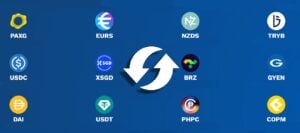
For a long time, the most popular stablecoins, like Tether (USDT) and USD Coin (USDC), have been tied to the US Dollar. But these dollar-pegged coins aren’t perfect. Many rely on a single company to hold the actual dollars that back the digital coins.
This can lead to questions about how trustworthy and open they truly are. For example, some companies can even freeze funds or ban certain digital addresses, which feels a bit too “centralized” for a world that aims to be “decentralized.” Even popular decentralized stablecoins, like DAI, often depend on outside information sources called “oracles.” The problem? These oracles can sometimes be tricked, leading to big losses, as seen in the $182 million hack on Beanstalk Farms in 2022.
The Rise of Non-USD Stablecoins: A New Wave of Digital Money
Because of these challenges, there’s a growing buzz around a new kind of stablecoin: ones that are tied to currencies other than the US Dollar. These “non-USD” stablecoins are gaining importance, driven by local economic needs, new regulations, and a desire for stability that matches different countries’ own money. If you live in Europe, you might prefer a stablecoin pegged to the Euro; in the Middle East, perhaps one tied to the UAE Dirham. This shift is making the stablecoin market more diverse and globally relevant.
One good example of a leader in this new wave of innovation is Frankencoin (ZCHF). Built on the Ethereum blockchain and is designed to track the value of the famous and highly stable Swiss Franc (CHF), Frankencoin aims to solve the problems of older stablecoins by being truly decentralized and transparent, letting users create their own Swiss Francs backed by collateral.
But Frankencoin isn’t the only player in this evolving space. Several other non-USD stablecoins are making their mark:
Tether UAE Dirham Stablecoin (XAED): Launched in 2024 by Tether, the same company behind USDT, XAED is pegged directly to the United Arab Emirates Dirham. It’s designed to meet the growing demand for digital currency in the Middle East, making digital transactions easier in that region. DWS’s Euro Stablecoin: Expected to launch in this year, this Euro-pegged stablecoin is being developed by DWS, a part of Deutsche Bank, along with other big names. It will be regulated by Germany’s financial authority, BaFin, ensuring it follows Europe’s new crypto rules (MiCA). This aims to boost Euro stablecoin use across Europe for institutions and everyday users. NZDS (New Zealand Dollar Stablecoin): This stablecoin is already up and running, pegged 1:1 to the New Zealand Dollar. It’s seeing more and more use on decentralized exchanges and offers stability for crypto users in New Zealand and beyond. Digital Ruble: While not a private stablecoin, Russia’s central bank digital currency (CBDC), the digital ruble, is expected to be widely used by 2025-2027. It’s a digital version of the Russian Ruble, backed by the state, showing how governments are also moving towards digital money. BRZ (Brazilian Real Stablecoin): This stablecoin, pegged to the Brazilian Real, is already well-known and continues to grow. It helps users in Latin America engage in DeFi and simplifies money transfers across borders.These examples clearly show a global trend toward stablecoins that are not tied to the US Dollar, driven by regional needs and a desire for more localized digital money. The stablecoin market is projected to reach an enormous $400 billion by the end of 2025, with daily payment volumes potentially hitting $300 billion, highlighting the huge growth in this area.
The Power of the Swiss Franc: A Foundation for Stability
So, why are these new stablecoins so appealing? And why is a currency like the Swiss Franc such a great choice for a stablecoin peg? The Swiss Franc (CHF) is famous worldwide for its rock-solid stability. This comes from several key factors:
Steady Prices: Switzerland has consistently kept inflation (the rate at which money loses its buying power) very low, usually around 1-2% each year. This means the Franc holds its value well over time. Safe Haven Status: During times of global economic or political trouble, people often flock to the Swiss Franc because Switzerland is politically neutral and has a very strong and reliable economy. Careful Management: The Swiss National Bank (SNB) carefully manages the Franc’s value through smart money policies, ensuring it remains stable and competitive. Strong Economy and Politics: Switzerland boasts a robust economy, low national debt, and a stable political system based on direct democracy. All these factors build confidence and make the Franc strong. Financial Hub: Swiss banks are known for being very stable and secure, attracting a lot of money from around the world, which further boosts demand for the Swiss Franc.These qualities make the Swiss Franc a perfect blueprint for digital stability, naturally appealing to both traditional investors and the fast-growing stablecoin market.
Exploring a Different Approach to Stablecoins
Building on the inherent stability of the Swiss Franc, Frankencoin introduces a blockchain-based approach to stablecoin creation. Its design incorporates several features that differentiate it from many existing models:
Independent of External Oracles: Unlike numerous decentralized stablecoins, such as MakerDAO’s DAI, which rely on external “oracles” for real-world price data, Frankencoin aims for self-sufficiency. It uses a unique internal auction system to determine the value of collateral during liquidation events. This mechanism is designed to reduce the system’s vulnerability to oracle manipulation attacks and potentially allows for a wider variety of collateral types, provided they can be effectively valued through these auctions.
User-Driven Collateralized Minting: Similar to other collateralized stablecoin systems like MakerDAO or Liquity, Frankencoin enables users to generate new ZCHF by depositing various digital assets as collateral. This process, often termed “minting,” allows users to create their own stablecoins against their assets, rather than receiving a loan from a central entity. The entire minting process is automated and transparent on the Ethereum blockchain, with a small fee contributing to the system’s internal reserves.
Veto-Based Governance: Frankencoin’s governance system deviates from the common proposal-and-vote models seen in many other DeFi protocols. It primarily operates on a “veto” mechanism. Holders of Frankencoin Pool Shares (FPS) can, individually or by pooling resources, gain the power to block proposals if they collectively hold at least 2% of the voting power. This voting power is tied to both the amount of FPS held and the duration they’ve been held, encouraging long-term engagement and aiming to allow collective influence over the system’s evolution.
Multi-Layered Stability Mechanisms: Maintaining a stable peg is paramount for any stablecoin. Frankencoin addresses this through a multi-layered reserve system, akin to how many other collateralized stablecoins manage risk. These reserves include funds from individual users minting ZCHF and capital contributed by FPS holders, which acts similarly to a bank’s equity. This structure is intended to absorb potential losses and support Frankencoin’s soft peg to the Swiss Franc, even if the value of backing collateral experiences significant fluctuations.
The Future of Stablecoins
The shift towards non-USD stablecoins is a clear sign that the cryptocurrency world is maturing and becoming more global. With projects like Frankencoin leading the way, offering innovative solutions that prioritize decentralization, transparency, and real-world stability, the future of digital money looks more diverse and resilient than ever. These new stablecoins are not just about digital payments; they are about empowering individuals and building a more robust financial system that reflects global economic needs.


 1 day ago
8
1 day ago
8 










 Bengali (Bangladesh) ·
Bengali (Bangladesh) ·  English (United States) ·
English (United States) ·